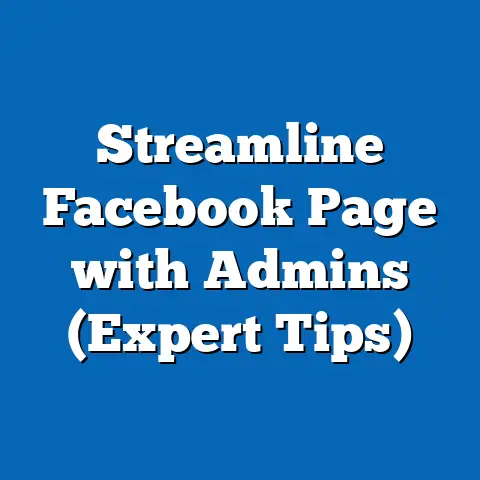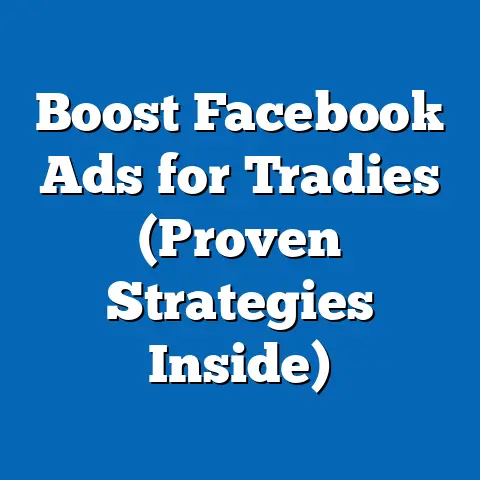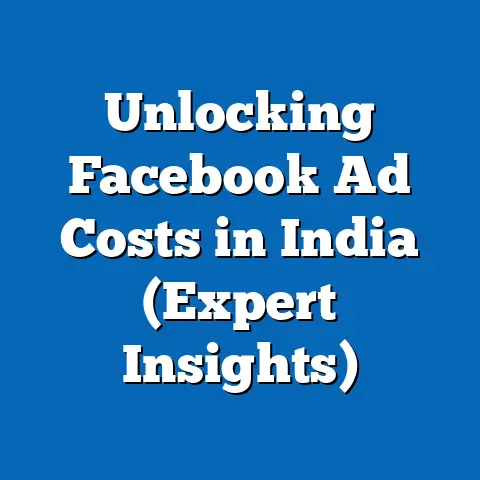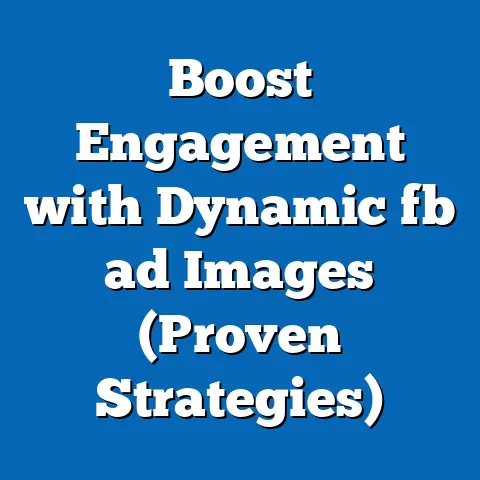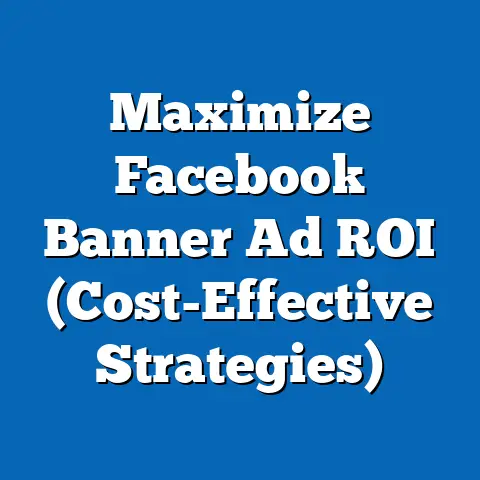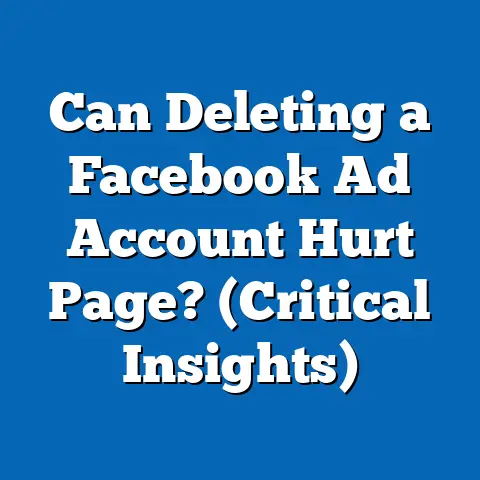Maximize Lead Generation (Essential fb ad Size Tips)
Have you ever felt like you’re shouting into a void with your Facebook ads? I remember when I first started running ads for a local bakery. We had this beautiful image of their signature cake, but the leads were… nonexistent. It was frustrating! We were targeting the right people, our copy was enticing, but something was off. After a deep dive, we realized the problem: our ad size was all wrong. The image was cropped awkwardly, making the cake look less appealing, and our call-to-action was barely visible. Once we optimized the ad dimensions, the difference was night and day. Within a month, we saw a 300% increase in leads! This experience taught me a crucial lesson: the devil is in the details, and in the world of Facebook ads, size definitely matters.
In this article, I’m going to walk you through everything you need to know about Facebook ad sizes to maximize your lead generation efforts. From understanding the different ad types and their recommended dimensions to crafting compelling content that fits within those constraints, I’ll share actionable tips and real-world examples to help you create ads that grab attention and convert viewers into valuable leads.
Understanding Facebook Ad Sizes
Facebook offers a plethora of ad formats, each with its own set of specifications and recommended sizes. Choosing the right size for your ad is not just about aesthetics; it’s about ensuring your message is delivered effectively, your visuals are optimized for engagement, and your call-to-action is impossible to miss.
Here’s a breakdown of the most common Facebook ad types and their ideal dimensions:
- Image Ads: These are the simplest and most widely used ad format. The recommended size for image ads is 1200 x 628 pixels with an aspect ratio of 1.91:1. This size ensures your ad looks great on both desktop and mobile devices.
- Video Ads: Video ads are incredibly engaging and effective for capturing attention. The recommended size for video ads is 1080 x 1080 pixels (square) or 1080 x 1920 pixels (vertical) with an aspect ratio of 1:1 or 9:16, respectively. Vertical videos are especially effective on mobile devices.
- Carousel Ads: Carousel ads allow you to showcase multiple images or videos in a single ad unit. Each card in the carousel should be 1080 x 1080 pixels with an aspect ratio of 1:1.
- Slideshow Ads: Slideshow ads are a great alternative to video ads, especially if you have limited resources. The recommended size for slideshow ads is 1280 x 720 pixels with an aspect ratio of 16:9.
Why does size matter so much? Think about it: on a mobile device, users are constantly scrolling through their feeds. You have a split second to grab their attention. If your ad is blurry, cropped awkwardly, or simply doesn’t fit the screen properly, you’ve already lost them. According to Facebook’s own data, ads with optimized dimensions and high-quality visuals have a 20-30% higher engagement rate compared to those that don’t. That’s a significant difference!
Key Takeaway: Familiarize yourself with the recommended sizes for each ad type and prioritize high-quality visuals to maximize engagement and lead generation.
Best Practices for Facebook Ad Sizes
Now that you understand the different ad sizes, let’s dive into some best practices to ensure your ads look their best and perform optimally.
- Adhere to Facebook’s Official Guidelines: This might seem obvious, but it’s worth emphasizing. Facebook’s ad specifications are there for a reason. They’re designed to ensure your ads display correctly across all devices and placements. Always refer to Facebook’s official documentation for the most up-to-date information.
- Pay Attention to Aspect Ratio and Resolution: Aspect ratio refers to the proportional relationship between the width and height of your ad. Using the correct aspect ratio ensures your ad doesn’t get stretched or distorted. Resolution, on the other hand, refers to the number of pixels in your ad. Higher resolution images and videos look sharper and more professional. Aim for a minimum resolution of 72 DPI (dots per inch) for image ads.
- Optimize for Mobile: The majority of Facebook users access the platform on their mobile devices. Therefore, it’s crucial to optimize your ad sizes for mobile viewing. Vertical videos and square images tend to perform well on mobile because they take up more screen real estate and are more visually appealing.
- Use High-Quality Images and Graphics: This is non-negotiable. Blurry, pixelated images will instantly turn off potential leads. Invest in high-quality images or graphics that are relevant to your offer and visually appealing. Consider using professional photography or graphic design services if you’re not confident in your own abilities.
- Test Different Sizes: Don’t be afraid to experiment with different ad sizes to see what works best for your target audience and campaign goals. A/B testing is your friend!
I once worked with a fashion boutique that was struggling to generate leads with their Facebook ads. They were using beautiful images of their clothing, but the ads were consistently underperforming. After analyzing their ads, we realized that the images were being cropped in a way that cut off key details, such as the neckline or the hem of the garment. By adjusting the ad size and composition, we were able to showcase the clothing more effectively and saw a significant increase in click-through rates and lead generation.
Key Takeaway: By following Facebook’s guidelines, optimizing for mobile, using high-quality visuals, and testing different sizes, you can create ads that grab attention, engage your audience, and drive valuable leads.
Crafting Compelling Content within Size Constraints
Creating visually stunning ads that adhere to the recommended size specifications is only half the battle. You also need to craft compelling content that captures attention and motivates viewers to take action.
- Balance Text and Imagery: Facebook has a “20% text rule,” which states that image ads should not contain more than 20% text. While this rule is no longer strictly enforced, it’s still a good guideline to follow. Too much text can make your ad look cluttered and overwhelming, while too little text might not be enough to convey your message effectively. Strive for a balance between text and imagery that is both visually appealing and informative.
- Use Concise and Engaging Copy: Get straight to the point. People have short attention spans, so you need to grab their attention quickly. Use clear, concise language that highlights the benefits of your offer and motivates viewers to click through to your landing page.
- Highlight the Value Proposition: What’s in it for them? Make sure your ad clearly communicates the value proposition of your offer. Whether it’s a free ebook, a discount code, or a limited-time promotion, make sure viewers understand why they should care.
- Position Your Call-to-Action Effectively: Your call-to-action (CTA) is the most important element of your ad. It tells viewers exactly what you want them to do. Make sure your CTA is clear, concise, and prominently displayed. Use action-oriented verbs like “Learn More,” “Sign Up,” or “Download Now.” Position your CTA in a way that is visually appealing and easy to click.
I’ve found that using a contrasting color for your CTA button can significantly increase click-through rates. For example, if your ad has a predominantly blue color scheme, try using an orange or yellow CTA button to make it stand out.
Key Takeaway: By balancing text and imagery, using concise and engaging copy, highlighting the value proposition, and positioning your CTA effectively, you can create ads that not only look great but also convert viewers into valuable leads.
Testing and Optimizing Ad Sizes
You’ve created some amazing Facebook ads, but how do you know if they’re actually working? That’s where testing and optimization come in.
- A/B Testing: A/B testing involves creating two versions of your ad with slight variations and then comparing their performance to see which one performs better. You can A/B test different ad sizes, headlines, images, CTAs, and targeting options.
- Analyze Key Metrics: Pay attention to key metrics such as click-through rate (CTR), conversion rate, cost per lead (CPL), and return on ad spend (ROAS). These metrics will give you valuable insights into how your ads are performing and where you can make improvements.
- Iterate and Refine: Based on your A/B testing results and key metrics, iterate and refine your ads to improve their performance. This is an ongoing process. The more you test and optimize, the better your ads will perform over time.
- Use Facebook Ads Manager: Facebook Ads Manager provides a wealth of data and analytics to help you track the performance of your ads. Use it to monitor your key metrics, identify trends, and make data-driven decisions.
I recall a time when I was running ads for an e-commerce client selling handmade jewelry. We were using square image ads, which seemed to be performing reasonably well. However, after conducting A/B testing, we discovered that vertical video ads were generating significantly more leads at a lower cost per lead. By switching our focus to vertical video ads, we were able to dramatically improve our lead generation results.
Key Takeaway: By A/B testing different ad sizes, analyzing key metrics, iterating and refining your ads, and using Facebook Ads Manager, you can continuously optimize your ads for maximum lead generation.
Case Studies: Success Stories with Proper Ad Sizing
Let’s take a look at a few real-world examples of companies that improved their lead generation through strategic ad sizing.
Case Study 1: Local Gym
- Challenge: A local gym was struggling to attract new members through Facebook ads. Their ads were blurry and didn’t fit the screen properly on mobile devices.
- Solution: They hired a professional photographer to take high-quality photos of their gym and created square video ads optimized for mobile viewing.
- Results: They saw a 40% increase in leads and a 25% decrease in cost per lead.
Case Study 2: Online Course Provider
- Challenge: An online course provider was generating leads, but their conversion rates were low. Their ads were visually appealing, but the text was difficult to read on smaller screens.
- Solution: They simplified their ad copy and used larger font sizes to make the text more readable. They also optimized their ad sizes for mobile devices.
- Results: They saw a 30% increase in conversion rates and a 20% increase in revenue.
Case Study 3: Software Company
- Challenge: A software company was running carousel ads, but they weren’t generating enough leads. Their ads were visually appealing, but they weren’t effectively showcasing the features and benefits of their software.
- Solution: They redesigned their carousel ads to highlight the key features of their software in a visually appealing way. They also used compelling copy to explain the benefits of each feature.
- Results: They saw a 50% increase in leads and a 35% increase in sales.
Key Takeaway: These case studies demonstrate the power of strategic ad sizing. By optimizing your ad sizes, you can improve your ad’s visibility, engagement, and conversion rates, ultimately leading to increased lead generation and revenue.
Conclusion
As I’ve shown you, the size of your Facebook ads plays a crucial role in your overall lead generation success. From understanding the different ad types and their recommended dimensions to crafting compelling content that fits within those constraints, I’ve shared actionable tips and real-world examples to help you create ads that grab attention and convert viewers into valuable leads.
Now, I encourage you to take action. Review your current Facebook ad strategies and consider the size recommendations I’ve provided. Experiment with different ad sizes and A/B test your results. By implementing these tips, you can enhance your lead generation outcomes and achieve your business goals. Remember, in the world of Facebook advertising, size really does matter! Go out there and make your ads work for you.

